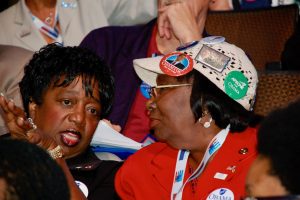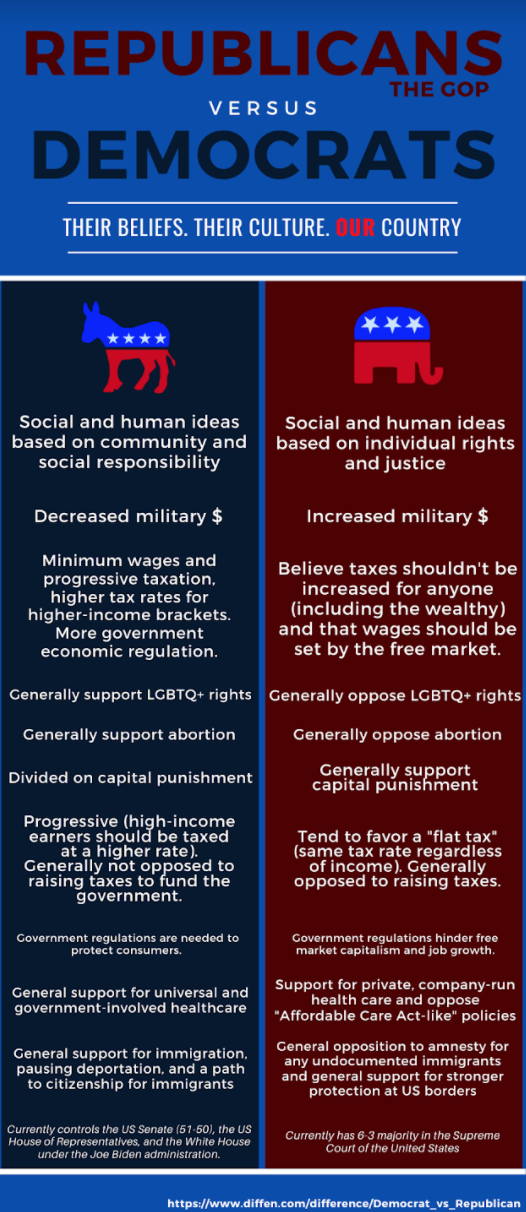9.3: Policy Preferences of U.S. Political Parties
- Page ID
- 134566
“The Republican Party is not, as advertised, conservative but radically oligarchical. Programmatically it exists to advance corporate economic and political interests, and to protect and promote inequities of opportunity and wealth.”
—Sheldon S. Wolin (1)
“Should Democrats somehow be elected, corporate sponsors make it politically impossible for the new officeholders to alter significantly the direction of society.”
—Sheldon S. Wolin (2)
How Political Scientists Analyze Parties
Political parties are complicated, and not at all easy to capture in U.S. Government textbooks. Political scientists tend to break the analytical problem down into three parts.
- The party in the electorate refers to the voters who support each party. People may support the Democratic or Republican parties—or one of the third parties—without formally registering as a party affiliate. Party affiliation tends to wander over time. Generally speaking, Republicans and Democrats each tend to constitute somewhere between 25-33 percent of the population, with Independents making up the rest. (4) Political scientists and survey researchers use the term party identification to refer to a voter’s self-identification with one party or another, whether or not they are formally party members. Through survey research, political scientists can make statements about the extent to which people who identify with one party support policy A versus policy B.

- The party organization deals with people who hold offices or volunteer positions in a political party at the local, state, or national level. They tend to be quite dedicated, devoting considerable time and effort promoting the party, its policies, and its candidates. Political scientists can study this finite number of people through both qualitative and quantitative methods. For instance, scholars can study the extent to which the political views of national party convention delegates are similar to or differ from those of rank and file party members. (5)
- The party in government refers to elected and appointed public officials who identify with one party or another. As with party organization, this is a relatively well-defined universe of people that can be subdivided into precise groups like members of the House of Representatives or U.S. Senators. Quantitative and qualitative measures are used to study behavior. For instance, the overall partisanship of Representatives and Senators can be analyzed by looking at the percentage of congressional votes that pit a majority of Democrats on one side voting against a majority of Republicans on the other side. Individual Representatives or Senators can be given partisanship scores for how closely they adhere to the party line, and those results can be compared to the voters’ views. (6)
Similarities and Differences Between the Democratic and Republican Parties
This chart examines the general differences between the policies and political positions of the Democratic and Republican parties on major issues such as taxes, the role of government, entitlements (Social Security, Medicare), gun control, immigration, healthcare, environmental policy and regulation.

Political Parties and the Economy
Democrats and Republicans have widely different views on the economy. But once in power, candidates’ actions don’t always coincide with their party’s views. That makes it difficult to determine which party is better for the economy.
.jpg?revision=1)
The Asymmetrical Nature of American Party Politics
In the modern era, the Democratic party is best characterized as a relatively non-ideological coalition of distinct groups like women, blacks, the LGBTQ community, Hispanics, labor unions, environmentalists, and so forth. It’s a “big tent” party whose constituent groups sympathize and often support each other, but who has not created a powerful ideology to animate them all. Absent an overarching liberal or progressive ideology, the “Democrats continue to address the concrete agendas of discrete social groups, preferring a governing style of technocratic incrementalism over one guided by a comprehensive value system.” (7) This may explain the difficulty that Bernie Sanders had in trying to become the Democratic party presidential nominee in 2016 and 2020.
On the other hand, the Republican part is notably characterized by “movement conservatism,” an ideology of individual liberty that unites and animates its members. Whenever its candidates lose, the Republican party tends to conclude that the reason for the loss was that its particular candidate in a given race was not ideologically pure enough. The Republican party unites business and religious interests under a conservative banner clearly intended to prevent any cracks in the economic or social hierarchies that have developed in the U.S. The conservative movement has shown “spectacular success in gaining control of the Republican Party.” (8) When outsider Trump gained the White House and became the Republican party’s de facto leader, conservatives either left the party to maintain ideological purity or tried to co-opt the opportunity to promote conservative ideological values in public policy and federal court nominations.
References
- Sheldon S. Wolin, Democracy, Inc.: Managed Democracy and the Specter of Inverted Totalitarianism. New Edition. Princeton: Princeton University Press, 2017. Page 187.
- Sheldon S. Wolin, Democracy, Inc.: Managed Democracy and the Specter of Inverted Totalitarianism. New Edition. Princeton: Princeton University Press, 2017. Page 201.
- L. Sandy Maisel, American Political Parties and Elections. A Very Short Introduction. Oxford: Oxford University Press, 2016. Pages 77-90.
- John Laloggia, “6 Facts About U.S. Political Independents,” Pew Research Center. May 15, 2019.
- Examples: Richard Herrera, “Are ‘Superdelegates’ Super?” Political Behavior. Vol, 16, No. 1. 1994. Jeanne Kirkpatrick, “Representation in the American National Conventions: The Case of 1972,” British Journal of Political Science, Vol. 5, No. 3. July 1975. Ronald Rapoport, Alan I. McGlennon, and John Abramowitz, The Life of the Parties: Activists in Presidential Politics. Lexington, Kentucky: University Press of Kentucky, 1986.
- For example, Logan Dancey and Geoffrey Sheagley, “Partisanship and Perceptions of Party Line Voting in Congress,” Political Research Quarterly, Vol. 71, No. 1. March 2018.
- Matt Grossman and David A. Hopkins, Asymmetric Politics: Ideological Republicans and Group Interest Democrats. New York: Oxford University Press, 2016. Page 101.
- Matt Grossman and David A. Hopkins, Asymmetric Politics: Ideological Republicans and Group Interest Democrats. New York: Oxford University Press, 2016. Page 79.
Media Attributions
- DSC_0633.JPG © David Hubert is licensed under a CC BY-NC (Attribution NonCommercial) license
- 911 © cattias.photos is licensed under a CC BY-NC-ND (Attribution NonCommercial NoDerivatives) license
- Corporate Taxes © National Priorities Project is licensed under a CC BY-NC (Attribution NonCommercial) license

